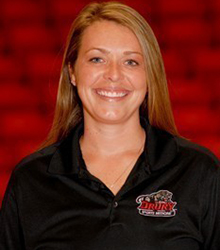

(Photo by Drury University)
The Scoop sat down with Drury University athletic trainers Erin Kineman and Summer Stewart to answer frequently asked questions about injuries and training.
What is the most common injury athletic trainers see?
“The things we treat are sprains of the joint or muscle strains, which are small tears in the muscles,” says Kineman, Drury’s head athletic trainer. “Tendinitis is also pretty common.”
How can an athlete prevent an injury?
Stewart, an assistant athletic trainer at Drury, says that not everything is preventable, but she has seen a common trend in the patients she sees because of how people hunch over computers, laptops and phones.
“It starts there,” Stewart says. “People are losing posture. If you fix posture and core and flexibility; it helps out.”
If someone has a weak core, it is going to be easier for that person to get knocked over and injured during any competition.
What is the difference between having an injury and being sore?
Kineman says that soreness should only last a couple days. When a pain starts to hang around for more than three or four days, it is possible that the pain is or has become an injury.
It is not unusual to be sore after coming back from a long break. After taking time off from working out, it is expected that the muscles will be sore, so it is important to make sure that training is done slowly and not all at once — because that is when injuries may occur.
Stewart says that if the soreness does not get taken care of, it can turn into an injury.
How can someone get rid of soreness?
Stewart says that stretching, foam rolling, and going over pressure points with a lacrosse ball are all good options.
When should someone stretch?
Stewart explains that a good stretching routine would consist of a warm-up followed by stretching, activity, then a cool-down followed by stretching.
How soon after someone first realizes they have pain should they see an athletic trainer?
Kineman says it is better to get it checked out quickly than to wait. The longer someone waits, the more likely the pain is to worsen.
What supplements are going to help athletes gain weight or muscles?
Kineman says that no supplements are regulated by the federal Food and Drug Administration. If someone has proper nutrition and proper sleeping habits, it should not be hard to keep the body healthy. Taking supplements is done at the risk of the athlete, and it should be recognized that supplements are not going to be miracle workers.
While Kineman and Stewart are specifically trainers for Division II athletes, they say that anyone who is training must be careful and watch for signs of having a serious injury.
